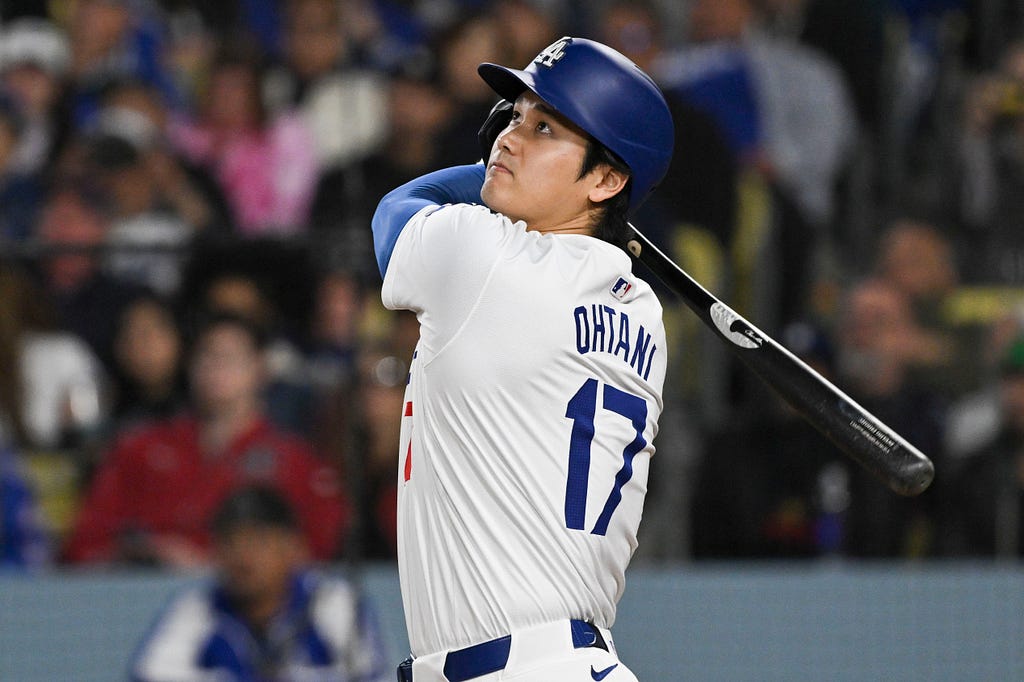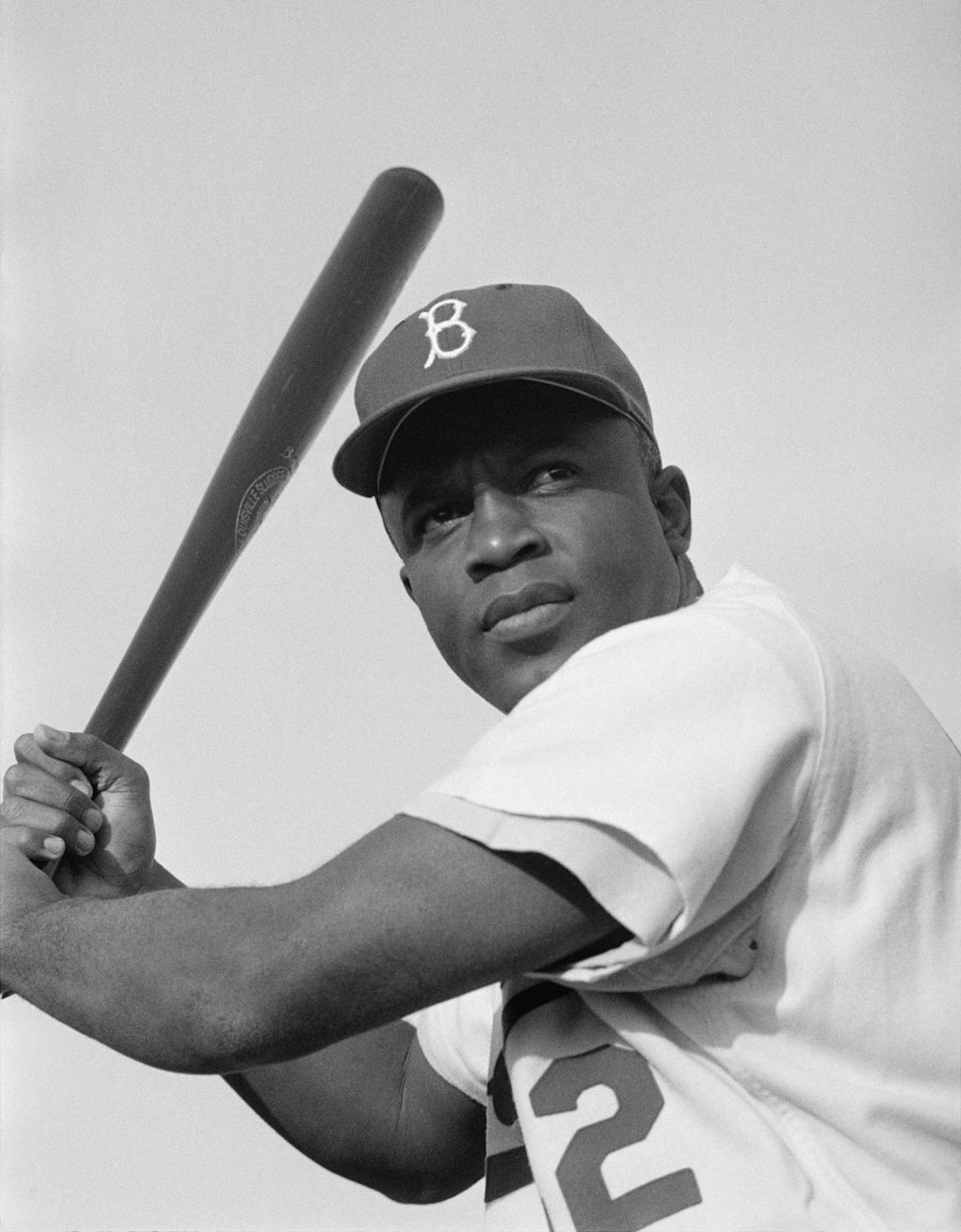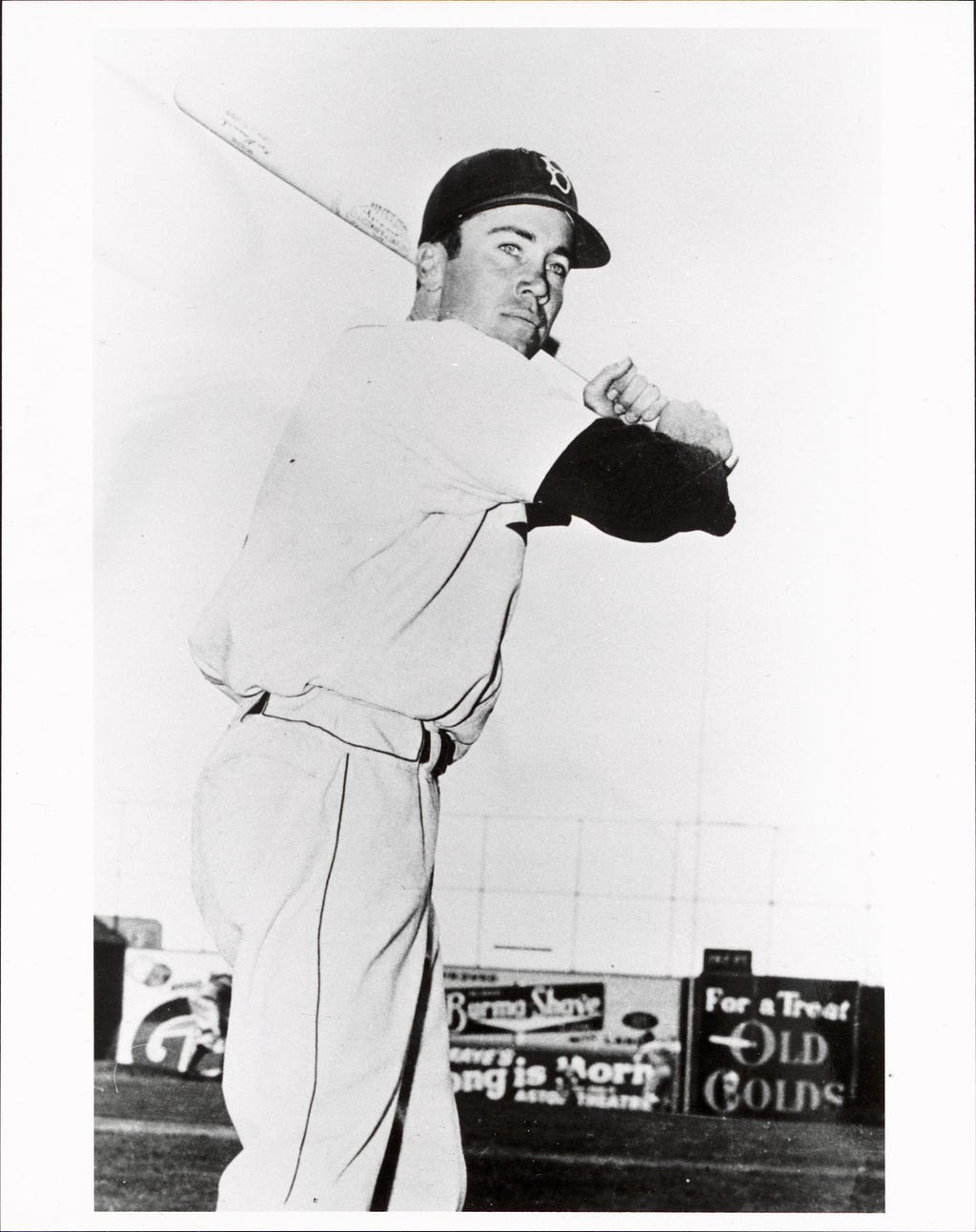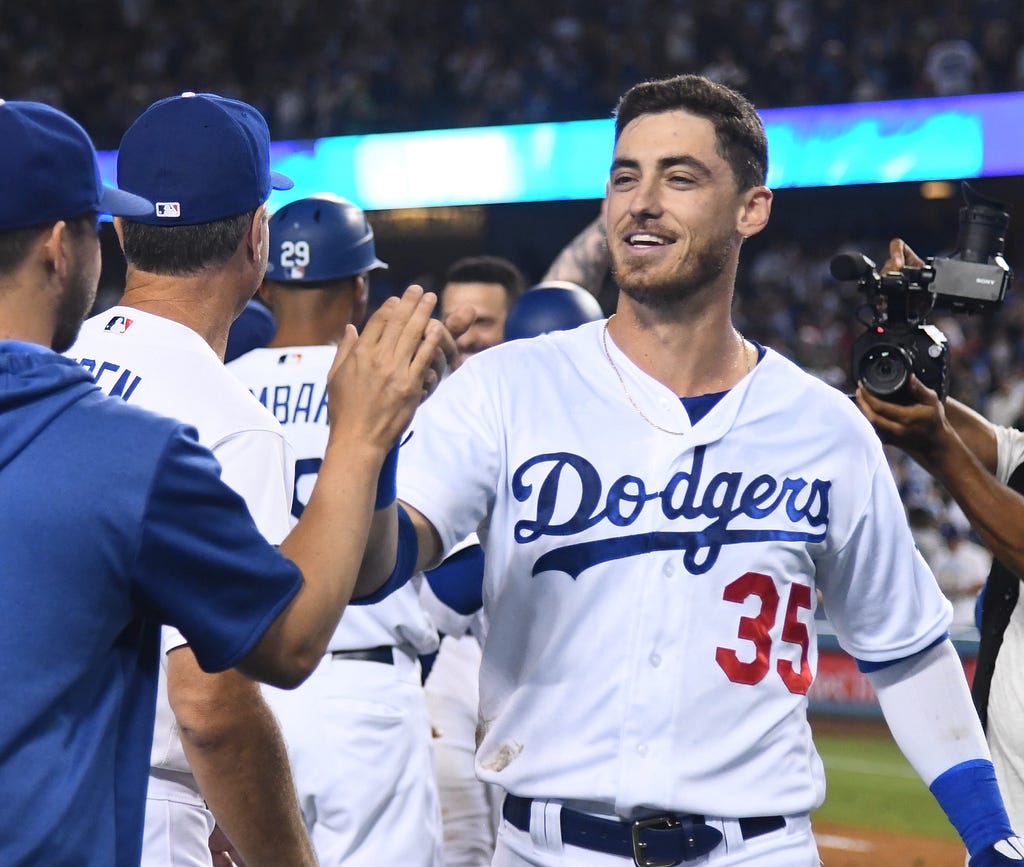
by Mark Langill
Less than a week before the Dodgers make their 2024 playoff debut on Saturday, it’s natural to look back and replay Shohei Ohtani’s historic debut season with Los Angeles. The designated hitter set many records while his dog, Decoy, added to the act, delivering the ceremonial first pitch on the player’s second bobblehead night of the season on Aug. 28.
But how does Ohtani’s statistical line measure up to his predecessors for a franchise that has played in the National League since 1890?
Here are the top 10 seasons, measured by Baseball-Reference WAR, by a non-pitcher in the Dodger history, with the obvious forewarning that Ohtani plans to resume both hitting and pitching duties in 2025.
1.Jackie Robinson (9.7 WAR in 1951) — During his 10-year career with the Dodgers, Robinson’s Brooklyn teams won six National League pennants and were twice eliminated on the final day of the season.
Although the 1951 season ended in heartbreak, Robinson played a major role in one of the epic pennant races in history. Brooklyn held a 13 1/2-game lead over the New York Giants on August 26. Manager Leo Durocher’s Giants staged a rally and forced a three-game playoff. The Giants eventually won the deciding third game, 5–4, on Bobby Thomson’s walk-off three-run home run off reliever Ralph Branca in the deciding third game at the Polo Grounds.
At age 32 in 1951, Robinson was in the middle of six consecutive All-Star seasons between 1949 and 1954. In 153 games, he batted .338/.429/.527/.957 with 19 home runs, 88 RBI, and 25 stolen bases in 33 attempts. In 642 plate appearances, Robinson had 79 walks and 27 strikeouts.
Robinson helped the Dodgers extend the regular season on Sept. 30 in the final regularly scheduled game at Philadelphia’s Shibe Park.
Both the Giants and Dodgers were tied for first place. While the Giants defeated the Boston Braves, 3–2, the Dodgers mounted a dramatic comeback against the Phillies after falling behind, 6–1, in the fourth inning. Brooklyn eventually tied the game, 8–8 to force extra innings.
In the 12th inning, the Phillies loaded the bases with two out. Eddie Waitkus hit a low line drive to the right of second base. Robinson dove for the ball and landed hard with the ball in his glove. He rolled over and weakly threw the ball to second base for a force. Pitcher Robin Roberts, running from third base, thought Robinson had trapped the ball. But umpire Lon Warneke called Waitkus out. In the 14th inning, Robinson hit a two-out home run off Roberts for a 9–8 victory.

2. Adrian Beltré (9.6 WAR in 2004) — His induction into the Baseball Hall of Fame in 2024 left Dodger fans wondering what might have been if Beltré had stayed in Los Angeles following his breakout 2004 season.
Beltré made his Major League debut at age 19 on June 24, 1998. His promotion from Double-A San Antonio was the first decision made by new Dodger general manager Tommy Lasorda, who believed the slick-fielding third baseman had already proven his potential in the Minor Leagues. He would become the first member of baseball’s 3,000-hit club to begin his career with the Dodgers.
But Los Angeles fans only saw the flashes of potential stardom early in Beltré’s 21-year career.
He sat out the first six weeks of the 2001 season after undergoing surgery to close a wound in his large intestine. Beltré was suffering from an infection following an emergency appendectomy in January.
Beltré in 2004 played most of the season with bone spurs in his left ankle. The painful condition led Beltré to alter his batting approach and become more patient at the plate.
Beltré hit .334/.388/.629/1.017 in 156 games with 48 home runs and 121 RBI to help the Dodgers win their first NL West title since 1995. He finished second in the National League MVP balloting to San Francisco’s Barry Bonds.
3. Jackie Robinson (9.3 WAR in 1949) — Robinson’s sophomore season with the Dodgers in 1948 set the stage for a triumphant 1949, in which he won the NL batting and stolen base titles.
He got off to a slow start in 1948 when he reported to Spring Training overweight to the consternation of manager Leo Durocher, coming off a one-year suspension. In his first 47 games, Robinson batted .290 but was 0-for-1 in stolen-base attempts as the Dodgers had a 25–29 record on June 24.
The Dodgers were 35–37 on July 16 when team president Branch Rickey let Durocher out of his contract to join the New York Giants. The low-key Burt Shotton, who managed Robinson during his Rookie of the Year campaign in 1947, returned to the Brooklyn dugout and Robinson flourished. He batted .296 in 147 games with 12 home runs, 85 RBI and 22 stolen bases in 36 attempts as Brooklyn (84–70) finished in third place, 7 ½ games behind the Boston Braves.
During Spring Training in 1949, Dodger special assignment scout George Sisler, a Hall of Fame first baseman and two-time American League batting champion, worked with Robinson to hit the ball to right field. Robinson used a batting tee, and the refined swing helped Robinson’s patience with breaking balls.
Everything clicked for the Dodgers in 1949 for the Dodgers and Robinson, who won National League MVP honors and the batting title as Brooklyn (97–57) won the pennant by one game over St. Louis. In 156 games, Robinson batted .342/.432/.528/.960 with 16 home runs, 124 RBI and 37 stolen bases in 53 attempts.
4. Shohei Ohtani (9.2 WAR in 2024) — Calculating Baseball-Reference WAR for position players includes batting, baserunning and fielding. His 59 stolen bases in 63 attempts made up for any missing defensive numbers as a full-time designated hitter while recovering from Tommy John elbow surgery.
Realistically, how can anyone measure the impact of Ohtani’s first season with the Dodgers after coming into 2024 with sky-high expectations?
Or the unforgettable moments, including his walk-off grand slam against Tampa Bay on Aug. 23 to join the 40–40 club. His 50–50 plateau occurred Sept. 19 in Florida — 6-for-6 with three home runs, 10 RBI and two stolen bases. If that wasn’t enough, Ohtani entered the final weekend of the regular season with a chance at becoming the first National League player since Joe Medwick of the 1937 St. Louis Cardinals to win the triple crown.
Ohtani batted .310/.390/.646/1.036 in 159 games. His 54 home runs surpassed the previous Dodger team record set by Shawn Green, who hit 49 in 2001. His 99 extra-base hits are five more than the previous mark set by Babe Herman in 1930.
Overall, Ohtani led the NL in home runs, RBI (130), on-base percentage (.390), slugging percentage (.646), OPS (.1.036). His 411 total bases are the most in the Majors since 2001.
Ohtani’s 59 stolen bases ranked second in the NL behind Cincinnati’s Elly De La Cruz (67). Ohtani became only the third player in history to finish in the top two in both home runs and stolen bases, joining Hall of Famers Honus Wagner (1908 Pittsburgh Pirates) and Ty Cobb (1909 Detroit Tigers).
Maybe in a decade, Ohtani’s 2024 statistics will be better appreciated, along with his Babe Ruth hitting-pitching storylines. For the moment, it feels like we’re watching a movie that can’t possibly be true.
5. Duke Snider (9.1 WAR in 1953) — Like Robinson, Snider has multiple seasons in the top 10 WAR rankings among Dodger position players. Yet the Hall of Fame outfielder didn’t win a National League MVP during an era when Dodgers won the award five times between 1949 and 1956. Snider came closest in 1955 when teammate Roy Campanella edged him in the balloting (226–221 points) as one of the 24 writers left Snider off their ballot.
The 1953 Dodgers (105–49), who won the pennant by 13 games over Milwaukee, still own the highest winning percentage in Dodger history (.682) for a full season. But the 1953 season ended on a disappointing note as the Yankees beat the Dodgers in the World Series in six games. During the regular season, Snider batted .336/.419/.627/1.046 in 153 games with 42 home runs and 126 RBI. He led the league in runs (132) and total bases (370). He finished third in the NL MVP balloting (157 points) behind Campanella (297) and Milwaukee’s Eddie Mathews (216).

6. Dan Brouthers (8.8 WAR in 1892) — The only 19th century player on the list, the power-hitting first baseman spent only two of his 19-year career with Brooklyn in 1892 and 1893. He was a career .342 hitter who won five league batting crowns, including 1892 with Brooklyn when he batted .335/.432/480/.911 in 152 games with five home runs and 124 RBI while playing at Brooklyn’s Eastern Park. He won the NL batting title that season, the first player in franchise history to do so.
He was elected to the Baseball Hall of Fame in 1945.
7. Mike Piazza (8.7 WAR in 1997) — The 1993 NL Rookie of the Year made his final full season with the Dodgers memorable as the catcher displayed both power and average while carrying the Dodger offense. In 152 games, Piazza batted .362/.431/.638/1.070 with 40 home runs and 124 RBI. On Sept. 21, he became the first and still only Dodger to hit a home run over the pavilion roof at Dodger Stadium. He also became the first Major League catcher to record 200 hits in a season. For the second consecutive season, Piazza finished second in the NL MVP balloting.
8. Cody Bellinger (8.6 WAR in 2019) — During his first three seasons with Los Angeles, Bellinger hit 111 home runs, including 39 in his Rookie of the Year campaign in 2017. Bellinger won NL MVP honors in 2019 when he batted .305/.406/.629/1.035 in 156 games with 47 home runs and 115 RBI. Bellinger led the league in total bases (351) as he became the first Dodger position player to win an MVP award since Kirk Gibson in 1988.

9. Duke Snider (8.6 WAR in 1955) — The most rewarding season of Snider’s career occurred in 1955 when the Dodgers won their first and only championship in Brooklyn history. Snider, a member of four previous pennant winners that lost to the Yankees between 1947 and 1953, got off to a hot start in 1955 as the Dodgers began the regular season with records of 10–0 and 22–2. In his first 10 games, Snider batted .361 with four home runs and 13 RBI. The Dodgers (98–55) ran away with the pennant and finished 13 1/2 games ahead of the Braves. Overall, Snider hit .309/.418/.628/.1.046 in 148 games with 24 home runs and a league-leading 136 RBI and 126 runs scored.
In the World Series, Snider became the first player to hit four home runs in two different Fall Classics, matching his 1952 feat. The Dodgers lost the first two games of the World Series against the Yankees, but eventually pulled out a 2–0 victory in the deciding Game 7 at Yankee Stadium behind left-hander Johnny Podres’ complete-game shutout.
10. Jackie Robinson (8.4 WAR in 1952) — This was Robinson’s final season as the Dodgers’ regular second baseman. He switched to third base and the outfield in 1953 to make room for rookie Jim Gilliam. In 1952, Robinson batted .308/.440/.465/.904 with 19 home runs, 75 RBI and 24 stolen bases in 149 games.
Ohtani among all-time Dodger seasons was originally published in Dodger Insider on Medium, where people are continuing the conversation by highlighting and responding to this story.